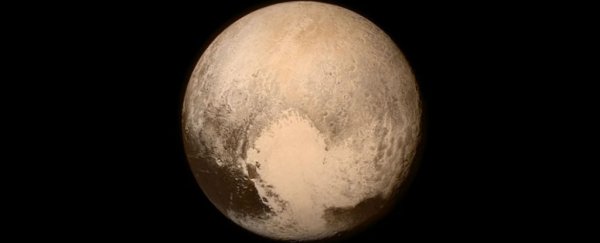When Pluto was ousted from the ranks of planethood about a decade ago, people were aghast. Here was a former 'planet' many of us had learned about in school, now relegated to mere 'dwarf planet' status by virtue of its modest size and some other quibbling technicalities. The indignity of it all!
Since then – and particularly recently in light of much excitement over the ongoing discoveries made by NASA's New Horizons mission – there have been repeated calls for Pluto to be promoted back to the ranks of planets proper, but according to a proposal for new criteria to define what a planet is, Pluto sadly still doesn't make the cut.
Jean-Luc Margot, an astronomer with the University of California, Los Angeles (UCLA), says the current 2006 definition for what makes a planet, which was determined by the International Astronomical Union (IAU) in somewhat controversial circumstances, applies only to bodies in our Solar System, creating "definitional limbo" for newly discovered bodies.
The current definition is a planet is a celestial body that orbits the Sun (meaning our Sun, not any other star), is nearly round, and can clear the neighbourhood around its orbit – which means that it is the dominant body in its region of space.
As framed by the IAU in 2006, this definition only applies to planets in our own Solar System, and that's a problem. Extrasolar planets, also known as exoplanets, are covered separately under a complementary 2003 draft guideline for the definition of planets, although it hasn't been universally accepted.
The chief problem with the definition of 'planet' then, as Margot explains, is that it discounts the thousands of exoplanets we know about that exist in other solar systems. And that's not all.
"Beyond that, the roundness criterion is problematic," he told Deborah Netburn at the Los Angeles Times. "The size at which an object becomes round spans a whole range of values depending on its temperature, interior strength and thermal evolution. None of these things are observable from Earth for exoplanets right now."
Instead, Margot's proposal, viewable online at arXiv.org and set to be published in The Astronomical Journal, states that a planet should be defined as a celestial body that is in orbit around one or more stars or stellar remnants, which has sufficient mass to clear the neighbourhood around its orbit, and has a mass below 13 Jupiter masses.
According to the astronomer, this simpler and less arbitrary definition provides numerous benefits, and will make it easier for us to consistently identify and practically recognise new exoplanets as we discover them. Plus, it's a definition for a planet that applies to everything out there that qualifies, regardless of where that happens to be.
"There is an equation behind it, and that removes some of the ambiguities in the existing definition," he said. "Also, when you write down the equation for clearing an orbit to a specific extent in a specific time frame, it turns out that it depends only on the mass of the star, the mass of planet and the orbital period of the planet. One of the main advantages of the proposed criterion is all those things can easily be measured by Earth – and space-based telescopes."
It's unknown whether the new proposal will be accepted by the IAU, although it's probable the body will consider it at its next general assembly in 2018. One of the factors that may make the revised definition more palatable to the scientists calling the shots is that it draws upon concepts previously considered by the IAU – and importantly, doesn't rock the boat in terms of what's considered a planet inside our own Solar System.
"Pluto's status isn't changed. Pluto is not a planet. It very clearly fails to clear its orbital zone, by this definition or the previous definition," Margot said. "I love Pluto. It is an amazing and fascinating world that is worthy of study, and none of that is diminished because of its classification."
